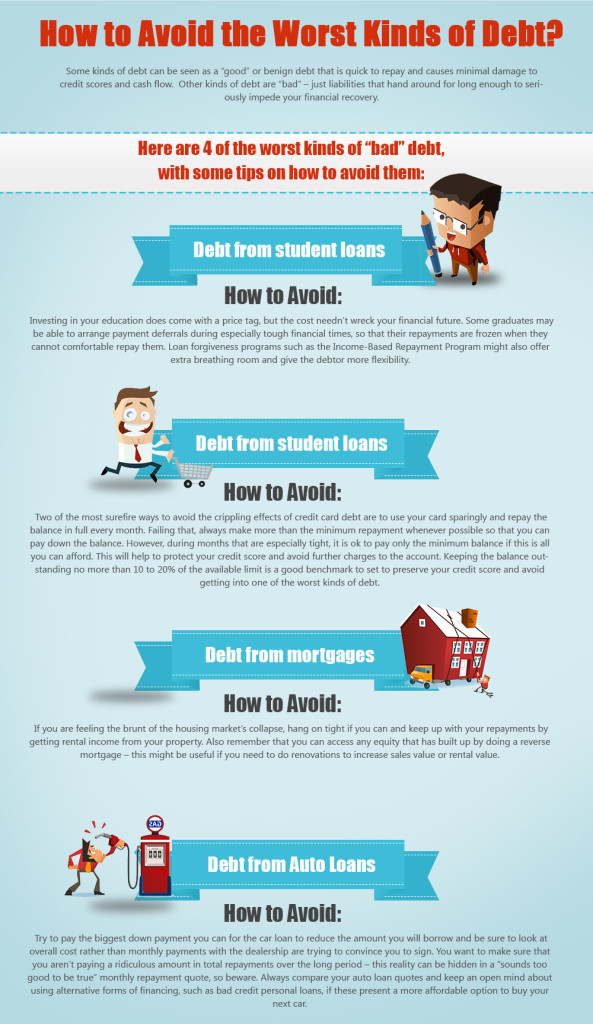 0
0 0
0 0
0 0
0 Some forms of debt are more damning than others. It is important to know this when prioritizing debt repayments – tacking those that are able to inflict the greatest amount of damage first is the ultimate goal. An even better approach is to avoid these debts from swallowing your finances in one big gulp.
Some forms of debt are more damning than others. It is important to know this when prioritizing debt repayments – tacking those that are able to inflict the greatest amount of damage first is the ultimate goal. An even better approach is to avoid these debts from swallowing your finances in one big gulp.
Good debt vs. bad debt
Some kinds of debt can be seen as a “good” or benign debt that is quick to repay and causes minimal damage to credit scores and cash flow. Other kinds of debt are “bad” – just liabilities that hand around for long enough to seriously impede your financial recovery.

The Worst Kinds of Debt Infographic (scroll down if you want to use it on your website)
Here are 4 of the worst kinds of “bad” debt, with some tips on how to avoid them:
1) Debt from student loans
Without a doubt, debt from student loans is one of the worst kinds of debt. The reasons for this are numerous – the loans are made to young people that typically have little to no previous credit history or experience. Before they have even started to create a positive credit history, students amount tens and thousands of dollars’ worth of debt. The debt is also borrowed against the hope of earning enough post-graduation to afford hefty repayments – the student doesn’t even have a steady income to bank on when the debt is accrued. For students that continue to study second and third degrees, the debt just increases exponentially while their income may never kick in at a high enough threshold to start repayments. The debts from student loans take on average 15 – 25 years to repay and are extremely hard to discharge in bankruptcy.
How to Avoid: Investing in your education does come with a price tag, but the cost needn’t wreck your financial future. Some graduates may be able to arrange payment deferrals during especially tough financial times, so that their repayments are frozen when they cannot comfortable repay them. Loan forgiveness programs such as the Income-Based Repayment Program might also offer extra breathing room and give the debtor more flexibility.
2) Debt from Credit Cards
It’s the interest rates associated with credit cards that make them such a pernicious form of debt and one of the most cumulatively expensive ways to borrow. The average rate of interest is around 15% but this pushes upwards of 20% plus for people with bad credit. People often find themselves caught in a trap of interest payments, late charges and barely touching the capital balance for years in some cases.
How to Avoid: Two of the most surefire ways to avoid the crippling effects of credit card debt are to use your card sparingly and repay the balance in full every month. Failing that, always make more than the minimum repayment whenever possible so that you can pay down the balance. However, during months that are especially tight, it is ok to pay only the minimum balance if this is all you can afford. This will help to protect your credit score and avoid further charges to the account. Keeping the balance outstanding no more than 10 to 20% of the available limit is a good benchmark to set to preserve your credit score and avoid getting into one of the worst kinds of debt.
3) Debt from mortgages
According to CoreLogic, 8.8 million homeowners can attest to the crippling effects of mortgage debt, as this many homes were in negative or near-to-negative equity in the second quarter of 2013. The potential losses of home ownership are now felt by millions of Americans who have paid more for their properties that they are worth. The future for them is one of colossal debt, unless the market picks up miraculously to offset these losses. What this also means is that the homeowners in negative equity cannot sell their homes without needing to find extra cash to pay off the shortfall from the mortgage. The other option is to go for a “short sale” and make a loss and damage their credit scores.
How to Avoid: If you are feeling the brunt of the housing market’s collapse, hang on tight if you can and keep up with your repayments by getting rental income from your property. Also remember that you can access any equity that has built up by doing a reverse mortgage – this might be useful if you need to do renovations to increase sales value or rental value.
4) Debt from Auto Loans
According to Eddmonds.com, the average vehicle loan is 66 months in American – that’s 5.5 years. Furthermore, 12% of all auto loans last 6-7 years. This means that car payments last much longer than repair warranties and maintenance insurance, which will invariably start to add up in cost during the middle of the loan period. This is one of the worst kinds of debt because many car owners are stuck if they find themselves needing to sell their vehicle before the loan is repaid. Being “upside down” and owing more the car is worth is a common predicament that leaves many drivers out of serious pocket.
How to Avoid: Try to pay the biggest down payment you can for the car loan to reduce the amount you will borrow and be sure to look at overall cost rather than monthly payments with the dealership are trying to convince you to sign. You want to make sure that you aren’t paying a ridiculous amount in total repayments over the long period – this reality can be hidden in a “sounds too good to be true” monthly repayment quote, so beware. Always compare your auto loan quotes and keep an open mind about using alternative forms of financing, such as bad credit personal loans, if these present a more affordable option to buy your next car.
What do you think are the worst kinds of debt? Have you struggled the most with credit cards, car loans or mortgage repayments? Share your experiences with us by le
Download this infographic.

